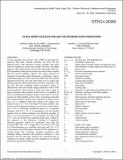Ultra-Short Nacelles for Low Fan Pressure Ratio Propulsors
Author(s)
Lord, Wesley K.; Rose, Becky; Peters, Andreas; Spakovszky, Zoltan S
DownloadV01AT01A029-GT2014-26369.pdf (9.741Mb)
PUBLISHER_POLICY
Publisher Policy
Article is made available in accordance with the publisher's policy and may be subject to US copyright law. Please refer to the publisher's site for terms of use.
Terms of use
Metadata
Show full item recordAbstract
As the propulsor fan pressure ratio (FPR) is decreased for improved fuel burn, reduced emissions and noise, the fan diameter grows and innovative nacelle concepts with short inlets are required to reduce their weight and drag. This paper addresses the uncharted inlet and nacelle design space for low-FPR propulsors where fan and nacelle are more closely coupled than in current turbofan engines. The paper presents an integrated fan-nacelle design framework, combining a splinebased inlet design tool with a fast and reliable body-force-based approach for the fan rotor and stator blade rows to capture the inlet-fan and fan-exhaust interactions and flow distortion at the fan face. The new capability enables parametric studies of characteristic inlet and nacelle design parameters with a short turn-around time. The interaction of the rotor with a region of high streamwise Mach number at the fan face is identified as the key mechanism limiting the design of short inlets. The local increase in Mach number is due to flow acceleration along the inlet internal surface coupled with a reduction in effective flow area. For a candidate short-inlet design with length over diameter ratio L/D = 0.19, the streamwise Mach number at the fan face near the shroud increases by up to 0.16 at cruise and by up to 0.36 at off-design conditions relative to a long-inlet propulsor with L/D = 0.5. As a consequence, the rotor locally operates close to choke resulting in fan efficiency penalties of up to 1.6 % at cruise and 3.9 % at off-design. For inlets with L/D < 0.25, the benefit from reduced nacelle drag is offset by the reduction in fan efficiency, resulting in propulsive efficiency penalties. Based on a parametric inlet study, the recommended inlet L/D is suggested to be between 0.25 and 0.4. The performance of a candidate short inlet with L/D = 0.25 was assessed using full-annulus unsteady RANS simulations at critical design and off-design operating conditions. The candidate design maintains the propulsive efficiency of the baseline case and fuel burn benefits are conjectured due to reductions in nacelle weight and drag compared to an aircraft powered by the baseline propulsor.
Date issued
2014-06Department
Massachusetts Institute of Technology. Department of Aeronautics and AstronauticsJournal
Volume 1A: Aircraft Engine; Fans and Blowers
Publisher
American Society of Mechanical Engineers
Citation
Peters, Andreas, Zoltán S. Spakovszky, Wesley K. Lord, and Becky Rose. “Ultra-Short Nacelles for Low Fan Pressure Ratio Propulsors.” Volume 1A: Aircraft Engine; Fans and Blowers (June 16, 2014).
Version: Final published version
ISBN
978-0-7918-4557-8